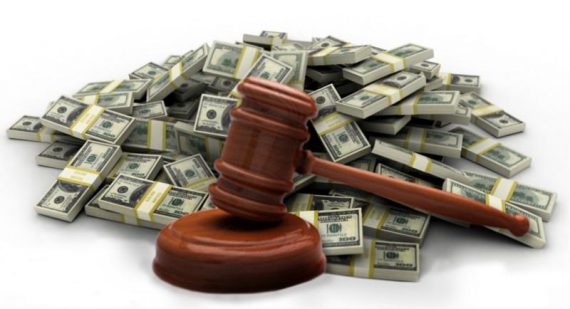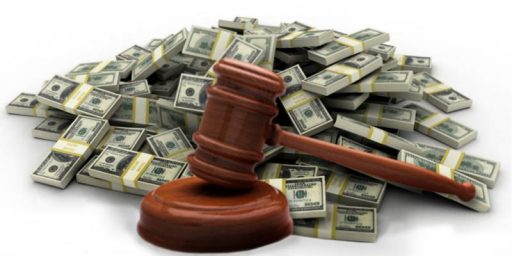Supreme Court Voids $3.4 Million Restitution Award To Child Pornography Victim
The Court gets the result right, but their reasoning will make things much more difficult for courts, defendants, and victims.
There were two more decisions handed down by the Supreme Court today, and while neither of them were quite as compelling as either the Michigan Affirmative Action case or the 4th Amendment decision I wrote about this morning, one of them touches on an issue we’ve discussed here before. In that case, Paroline v. United States, the Court voided a $3.4 million restitution order granted to a woman who had been depicted in child pornography from a person who had been convicted of possessing some of the images but otherwise had no connection to the woman’s abuse:
WASHINGTON — The Supreme Court on Wednesday set aside a $3.4 million award to a victim of child pornography who had sought restitution from a man convicted of viewing images of her. That figure was too much, Justice Anthony M. Kennedy wrote for a five-justice majority, returning the case to the lower courts to apply a new and vague legal standard to find a lower amount that was neither nominal nor too severe.
The victim in the case said the majority’s approach was confusing and meant that she might never be compensated for her losses.
The two dissents to the majority opinion would have taken more categorical approaches. Chief Justice John G. Roberts Jr., joined by Justices Antonin Scalia and Clarence Thomas, said that restitution was a worthy goal, but that the federal law at issue did not allow awards when many people had viewed the images.
Justice Sonia Sotomayor took the opposite view, saying that each viewer could be held liable for the full amount of the victims’ losses.
The case arose from the prosecution of Doyle R. Paroline, who was convicted in 2009 of possessing 280 images of child pornography. Two of them were of a woman known in court papers as Amy.
Images of Amy being sexually assaulted by her uncle as a child have been widely circulated and have figured in thousands of criminal cases. Amy has often sought restitution for her losses under a 1994 federal law. Every viewing of child pornography, Congress found, “represents a renewed violation of the privacy of the victims and repetition of their abuse.”
Amy’s lawyers say her losses — for lost income, therapy and legal fees — amount to $3.4 million. She has been granted restitution in about 180 cases and has recovered about 40 percent of what she seeks.
The 1994 law allows victims of child pornography to seek the “full amount” of their losses from people convicted of producing, distributing or possessing it, and Amy asked the United States District Court in Tyler, Tex., to order Mr. Paroline to pay her the full $3.4 million.
Mr. Paroline said he owed Amy nothing, arguing that her problems did not stem from learning that he had looked at images of her. Amy’s uncle, who was sentenced to 12 years in prison for his crimes, bore the brunt of the blame, Mr. Paroline said, but was ordered to pay Amy just $6,325.
Mr. Paroline was sentenced to two years in prison, but the trial judge said Amy was not entitled to restitution, saying the link between Amy’s losses and what Mr. Paroline did was too remote.
The United States Court of Appeals for the Fifth Circuit, in New Orleans, disagreed and awarded Amy the $3.4 million she sought. Mr. Paroline should pay what he could and seek contributions from his fellow wrongdoers if he thought it was too much, the court said, relying on the legal doctrine of “joint and several” liability.
The Supreme Court adopted neither of the lower courts’ approaches. Acknowledging that he was employing “a kind of legal fiction,” Justice Kennedy said the only sensible method of apportionment was for courts to require “reasonable and circumscribed” restitution “in an amount that comports with the defendant’s relative role.”
“This cannot be a precise mathematical inquiry and involves the use of discretion and sound judgment,” Justice Kennedy wrote. Justices Ruth Bader Ginsburg, Stephen G. Breyer, Samuel A. Alito Jr. and Elena Kagan joined the majority opinion.
Lyle Denniston has also summarized the opinion:
The decision clearly will spare a Tyler, Texas, man, Doyle Randall Paroline, from paying all of the nearly $3.4 million that lawyers for a young woman identified only as “Amy” had demanded from him. Paroline had two images of her being photographed as her uncle sexually abused her when she was eight years old. Now a young woman, she had testified that “My life and my feelings are worse now because the crime has never really stopped and will never really stop.”
The Court ruled that a federal district court judge must calculate how much to assess against Paroline personally. There is no doubt, Justice Kennedy wrote, that Paroline “was part of the overall phenomenon” of distributing and keeping images of the abuse of Amy. He should have to pay his share and, Kennedy said, it must be enough to send the message that his part in the crime was not victimless.
Lawyers for “Amy” had insisted that Paroline, like everyone who has her images and looks at them, contributes to her continuing injury, so each of them should be required to pay the full amount for her losses, in whatever multiples of individuals are found and prosecuted for having the pictures.
The pictures of “Amy” being abused are among the most widely circulated child pornography images in this country and, apparently, around the world. The number of individuals possessing them — according to the Court — reaches into the thousands.
Only one Justice — Sonia Sotomayor — agreed with the demand for full restitution, but Sotomayor did so in dissent. Three other Justices, also in dissent, said that calculating each possessor’s share of the overall harm to “Amy” would necessarily be “arbitrary,” so there should be no restitution to her because Congress had “provided no mechanism” for calculating shares of the cause of her injury.
Justice Kennedy’s opinion took a position in the middle. It was joined by Justices Samuel A. Alito, Jr., Stephen G. Breyer, Ruth Bader Ginsburg, and Elena Kagan. Chief Justice John G. Roberts, Jr., wrote the dissent arguing that there was no valid formula for restitution in the child pornography law. That dissenting opinion was joined by Justices Antonin Scalia and Clarence Thomas.
Justice Sotomayor’s dissent spoke only for herself, arguing that Congress had specified that restitution for the “full amount” of losses was mandatory, as part of the punishment for each one convicted of possessing child pornography involving the victim.
While the Kennedy opinion said that each defendant convicted of having images of “Amy” should be assessed for the degree to which his individual crime was the “proximate cause” of her injury, the Justice stressed that no mathematical formula could be devised for it.
While I haven’t had an opportunity to review the opinion in depth, it appears to me that the majority opinion has only made the job of future courts more difficult. How, exactly, is a judge or jury supposed to determine the relative degree of financial responsibility that a person possessing, say, a single image of child pornography has in the overall abuse that the child depicted therein has suffered? Given that we live in an age when such material can be easily, and surreptitiously traded online there would arguably be an incalculable numbers of copies of that file, so does that mean we have to divide the total amount of damages claimed by the victim by the number copies out there, assuming we can even determine what that number might be? And how do we factor the financial responsibility of the people who actually produced the child pornography into all of this? Shouldn’t they be held more responsible than the consumers of the product they produced since they are the ones who actually abused the child in question?
Given all of these uncertainties, it seems to me that the Roberts, Scalia, Thomas dissent is correct. The fact that we cannot come up with an objective determination of how restitution is to be apportioned means that no restitution should be awarded, at least not when it comes to the people who are merely viewing the images rather than producing or actually participating in them. Indeed, it’s easy to see how the majority’s approach here is going to cause nothing but problems for future courts, criminal defendants, and child pornography victims.
On some level, I agree with James Joyner’s assessment of this case in January when he suggested that the primary party that should be looked for when it comes to finanicial responsibility in this situation is the person who produced the child pornography. Indeed, it would arguably be a violation of due process to impose all of the financial burden for restitution on a person who only viewed images while the producer of the images is not held liable at all. However, there are arguably good policy reasons for imposing at least some level of responsibility for compensating victims on the people who view the images, especially given the fact that it is these viewers who end up paying the people who produce and traffic in the child pornography. If you are going to hold the viewers responsible though, due process would seem to require that there be an objective way to calculate the amount of restitution to be paid. The Court’s decision does the exact opposite and, as a result, virtually guarantees that this issue will be back before it in the future. Maybe in that future case, they’ll get it right.
Here’s the opinion:







Agreed. The reason that an objective determination of restitution cannot be made is simply because an objective determination of the nature of the crime doesn’t exist, either.
Postulate a bank robbery.
Certainly, not a victimless crime.
Postulate further that someone happens upon the scene and starts snapping pics of the robbery with a cell phone camera, let’s say.
Does said photographer get sued by the bank because bank robbery is “not a victimless crime”? On the same ground, are the people who buy newspapers in which those photos run, also sued?
Now, before you start tuning up, this is by no means a defense of pedofiles.
But if, as many have held, the law is reason devoid of emotion, then there must be an emotionless reason behind laws dealing with them, particularly if the law isn’t to be twisted into something to fill the gravy train.
Yes, because sexually molesting a minor and snapping pictures for the whole world to see is exactly the same thing as robbing a bank and snapping pictures of that crime…this really is one of the most idiotic (and that’s saying a lot) things you’ve ever written…
I haven’t read the decisions, but it seems to me that Sotomayor got it right. Its the court’s job to interpret the statute, which in this case called for “full” restitution. Restitution is a legal concept; the judges can interpret it, and determine when an order is excessive or unjust. There is nothing unjust about making a convicted felon who has millions of dollars to pay millions of damages proven to a victim.
@PD Shaw:
Especially when said felon was implicitly part of a distribution network — even if he didn’t intentionally share the files.
This is a point where the role of sharing technology cannot be ignored. The nature of digital means that Mr. Paroline played an important role in ensure the continued circulation of Amy’s images. The unfortunate truth is that the very nature of digital means that these photos will most likely never be able to be fully taken out of circulation. Which, for the victim is an incredibly traumatic thought. There is no way that she can ever put this fully behind her as, sadly, the images of the crime will most likely outlive her.
And we must not forget that both *possession* and *distribution* of child pornography *are both* crimes. Taking a photo of any other crime in progress is, of course, not a crime, unless you are participating in the action. Neither would be reproducing and distributing said photo. But that might go over some people’s heads.
@Matt Bernius: The concepts that should be hung on the felon here are quite familiar to civil defendants — defendants with lesser misconduct than others, but with deep pockets, are targeted to pay most of the damages. That includes civil defendants liable under “no fault” statutes, like “Superfund.” (Superfund also lacked provisions for calculating shares of responsibility, but the Courts looked to the Congressional record and found that the factors suggested by Senator Al Gore were reasonable, so Courts look to the “Gore factors,” even though Congress declined to pass them into law)
Huh?
Do you also believe that, in cases of joint guilt, an inability to objectively apportion guilt should mean that everyone is off the hook? Or everyone except some hypothetical “primary offender”?
Paroline is an accessory after the fact to a particularly revolting crime. (Or, according to the story up there, to dozens or hundreds of such crimes.) The fact that we haven’t caught all of the other accessories does not change his liability. The fact that the most culpable perpetrator apparently got off lightly does not change Paroline’s liability. If the other 100 victims can’t collect, let Amy stand in for them.
I think the Court got this one basically right — Paroline is responsible for some of the damage, but not all of it.
Congress wanted people like Paroline liable, but wrote a crappy law. The Court cannot write a new law, but they can send a very clear message that full enforcement is unconstitutional, and then dump the problem in someone else’s less precedent-setting laps until congress fixes the law.
A messy outcome for a messy case.
Therefor you feel that the getaway driver in an armed robbery is not as guilty as the triggerman when a murder takes place? Your statement does not conform with law as it is enforced in numerous circumstances.
Paroline is absolutely responsible for the full amount. As a consumer of child pornography he helps to create a market for it. It is ridiculous for the simple fact that others possess the image too to absolve him from responsibility to make retitution. The court has now created an incentive for anyone facing charges of possession of child pornography to make sure as many other people as possible have the same images. How on earth is that right?
I am not a lawyer and in no way could understand the verdict but I have a followup question – if Mr Paroline has proof about how many other people possess the image are all of those people now facing charges? If he cannot prove it how was this a legitmate defense even if the court was right?
@Pete S:
And again, in the digital age, any consumer is also a distributor.
Prior to this, in the days of physical images, one could in theory be a consumer without being a distributor.
Today, the very nature of digital means that Paroline was most likely helping distribute the files as well — either intentionally or unintentionally. The net result is that his action not only helped create and sustain a market for Amy’s photos, but they also helped get those photos into the hands of new individuals as they entered said (illegal) market.
@An Interested Party: Oh, puullleeeese.
Any example is going to be less than perfect.
But despite your emotionally delivered derision, you slide rather neatly into part of the point I am making, here.
What is the *objective* basis in law for the crimes being handled differently? That needs be defined before the culpability of the people besides the photographer can be established, don’t you think?
@Pete S: I think the numbers of how many other people have possessed the images come from the government. These people are sharing files with close groups of hobbyists, and as soon as the government finds one I think they are able to start tracking down others. In any event, the government keeps track of how much a child’s pictures have been shared, and the parents and the grown child have a right to know that information for the child’s personal safety (some fans might start stalking)
@Eric Florack:
The reason that your “bank robbery photo” analogy doesn’t work is that a bystander taking and distributing photographs of a crime in progress IS NOT A CRIME*.
Period. End of sentence. It’s a stupid analogy.
Making, taking, possessing, distributing images of child pornography ARE ALL CLEARLY DELINEATED CRIMES UNDER LOCAL AND FEDERAL LAW.
The reason that Paroline was sued was that he was *an active*, not to mention *convicted* participant in the crime in question (in that he possessed, and most likely helped distribute those *illegal/contraband* photos).
Nothing in the law makes taking a photo of a bank robbery illegal.
* – the only case where this would be a crime is, for example, child pornography. But in that case the bystander isn’t a bystander, but an active participant in the crime itself.
@Eric Florack: knowing possession of contraband
I’m somewhat surprised they went away from the jointly-and-severably-liable interpretation. In civil law there ‘s a very easy way around this: if you end up paying all the restitution to the victim but you’re only one of many people found guilty, you can turn around and sue the others to pay you so in the end you only pay your “fair share”.
End result? The victim gets compensated early on in the game and the guilty parties get to do the horsetrading and sniping at each other.
Probably SCOTUS came out the way it did because the original decision was bad: the uncle should have been responsible for far more $.
@Matt Bernius:
Suppose the government passed a law saying that a bystander taking photos of a bank robbery in progress and other persons distributing or possessing such photos was a felony.
Would such a law be constitutional?
@Stormy Dragon:
Are you being sarcastic? Or serious?
I need to know whether or not to take that questions seriously. Because the simple answer is that no way in hell would that ever be considered “Constitutional” as it’s a clear violation of the concept of *regulated* first amendment speech.
Regulated is a key concept there, btw as it also opens the door to why child porn is illegal even though we have the first amendment.
@Matt Bernius:
The question is serious, not in the sense of wanting it legalized, but in the sense of trying to make explicit the implied principles underlying the law. You seem to be dividing crimes up into two categories, one of which the government can ban photographs of, the other which it cannot.
What is the basis for this distinction and what determines which crimes go in which category? Can they ban possessing photos of a murder?
@Stormy Dragon:
Short answer – in the case of Child Pornoraphy, the media artifact is itself the crime. Otherwise it would just be a sexual abuse incident.
Photographing a crime — be it robbery or murder — doesn’t have the same effect. It may be in bad taste. But the recorded object is not — itself — illegal.
Its an incredibly limited category. In fact, I’m having a hard time thinking of anything else that falls into it. Further, the courts have struggled with the question of the media object and it’s relation to child pornography. Last I checked, creating and sharing imaginary renderings of child pornography (literary descriptions or drawings) are not crimes.
To some degree images created in the process of committing a crime by the people committing the crime (i.e. someone making a “snuff” film is an accessory to murder) cannot be used to create a profit for the perpetrators. And if someone could prove that they bystander had advanced knowledge of the crime, then they wouldn’t be a bystander any more.
@Matt Bernius:
If we banned bank robbery photos, the media artifact would itself be the crime there too. So this is just begging the question.
@Matt Bernius:
How about Eddie Adam’s pulitzer prize winning photo of General Nguyễn Ngọc Loan executing Capt. Nguyễn Văn Lém?
Reporters operate under their own standards. Adam’s always stated that it was a “reflex shot” — i.e. he saw it unfolding and photographed it as it was happening. That makes him a bystander/licensed observer, not an accomplice (though others like Susan Songtag have questions this reading, though there is no evidence to support this position other than interpretation of the image itself).
However, if Adam’s was a soldier, or had set up that shot (i.e. brought a man to be executed, etc). Then the case might be different.
@Stormy Dragon:
I’m sorry, I have to get off here.
You are missing the point. What is inherently illegal about a *bystander* taking a bank robbery photo? Nothing. And lacking that illegality, that’s why they are not able to regulated. Seriously, if something is to be made illegal, you need to at least tease out why it is illegal.
The fact is that there is a long history and scads of case law demonstrating why photographing/recording a crime in progress — as a bystander — is not illegal. Period.
A media artifact of child pornography, by the construction of child pornography laws, is inherently illegal. The photo itself is contraband. Arguably the most toxic form of a media artifact. Under laws — long in place and well tested — there’s no way for it not to be illegal if it is a recording of the crime (versus an imaginary creation) because the recording itself *is the crime* and reproducing the recording *is a crime.* It’s one of the very few examples, semiotically speaking, where the map is the territory itself. The child porn media artifact is 100% crime. There is no possible way to be a bystander in this scenario.*
Hence it falls clearly under regulatable speech.
A photo of a bank robbery or a murder, on the other hand, IS NOT THE BANK ROBBERY OR THE MURDER. And given the framework of the 1st amendment and two plus centuries of American case law (let alone international law), these are protected forms of speech (within, as always limits). There is no way to posit how a blanket ban on them would ever survive a constitutional test.
* – Ok, you could in theory remain a bystander if you were to come across someone engaging sexual abuse of a minor and recorded it as evidence. However, what you are doing there is taking footage for the police. You are not distributing it as *pornography*. If however, instead of going to directly to the police, you choose to go home and post it on reddit — even if it’s “help me nab this perv” — you’re most likely going to be in a lot of trouble (and potentially lose any bystander protections). I also tend to think that it’s difficult to construct a scenario in which there was no issue with you recording what was going on versus directly intervening.
People have a legally protected property interest in their image. Its not absolute — I cannot stop someone from taking my picture when I am in a public place. Some examples of privacy torts.
@Matt Bernius: Eh, perhaps.
But can you tell me in what other crime secondary parties are consider fully liable?
and again, on what objective basis is this crime treated differently?
Understand… Im not defending or attacking, here. The reax of most people to this crime is correct, if emotionally driven. Trouble is, emotionally driven people tend to make bad laws… laws which tend to open up problems of their own. Unintended consequences, and all that.
so, think, now…why is this crime treated differently? As an example, is it because it involves sex?
Gee, we just spent the last 25-plus years being told government had no place in such things.
are you really sure you wanna go there after all that?
@Matt Bernius:
A media artifact of bank robbery pornography, by the construction of bank robbery pornography laws, is inherently illegal. The photo itself is contraband.
@Stormy,
“Bank robbery pornography” is just a mish mash of words that makes no sense. You are just making stuff up to suit your argument.
@Eric Florack:
Child pornography is, in some ways, a very unique case. However, the individual in question is not a “secondary party” — he’s an accomplice. While he was not responsible for the creation of the image, purchasing/trading child pornography is a crime. Distributing it is a crime as well. He participated in the latter two acts.
By it’s very nature. Again. Possession is illegal. Distribution & trading is illegal.
Child pornography is a very complex area of the law because the objects being circulated are a pretty unique form of contraband.
No. Because it involves children having sex — most often against their will and with adults. Thats before we get to the selling/trading of these images.
There are TONS of issues in here from consent, to sexual abuse, rape, endangerment, human trafficking, on and on.
Seriously, I strongly suggest people actually do some research into child pornography and the related case law and theory.
The distribution of the porn is a separate crime. The background I read earlier, (which I cannot remember if it was about these specific victims or also others), was that the victims were abused a long-time ago, and probably prosecuted under state law for child rape. (Not a federal issue) The filming of the rape may have been underplayed at the time, or treated simply as evidence of the crime. The rape itself would have been the charge that gave the most time, though the sentence was probably minor by today’s standards (10 yrs).
The subsequent ability to digitalize the film and distribute it through the internet was a game-changer. Now, thousands of people are sharing the video, implicating federal laws against material showing the sexual exploitation of children in interstate commerce. The distribution constitutes a separate harm, made more apparent by victim stories in which they weren’t even aware that of the rape or that the rape were filmed. Nor is it clear that the original rapist(s) were involved in uploading the images to the net. Could have been a Sheriff, like the one the SCOTUS just bailed-out from losing part of his pension.
Separate crimes, separate harms, though the harm of distribution does relate back to the original harm.
@PD Shaw:
*THIS*
Thank you PD for putting it so smartly and addressing the technological issues underpinning part of the problem/this case.
Matt Bernius answered this drivel very well…the question is, how could anyone not realize how child sex is very different from any other crime and any images of that act is horrifying just like the original crime itself…
Indeed…like giving President Bush carte blanche to invade Iraq…or the attempts to completely outlaw abortions under any circumstances…or all the laws passed after 9/11 that were supposedly put in place to keep us safe…
@Matt Bernius: The point you sidestepped, there, is the inconsistencies. Such things make for bad law.
And let us remember the success stories with government banning things, huh?
There’s also one big difference: no one stages a bank robbery to take pictures of it and sell the pictures.
And Eric–no, it’s not inconsistent. There are a lot of areas of law where we have different rules for different situations.
@Matt Bernius:
On what precise legal basis?
You see, here’s the issue. Special cases tend to make bad law, and bad rulings tend to spawn more bad rulings.
That statement, that charge, implies a partnership… one which does not in fact exist. The two individuals don’t know each other, There was no p[lanning, no forethought to even suggest the possibility of the status of “accomplice” Is this relationship given a broader range arbitrarily because of the crime in question? Again, bad law, bad rulking, increased risks to freedoms.
I understand your desire to deal with such crimes with a firm hand, and believe it or not I actually approve of the sentiment. However, it strikes me as dangerous in terms of unintended consequences.
You know, it’s interesting. We have seen the drug enforcement efforts of government around the world, and most particularly here in the states derided by those who call it an unwarranted expansion of government power… and they warn that such drug law enforcements can leak into other areas of our jurisprudence. Yet, it seems few understand… or at least admit they understand… the similar danger here..